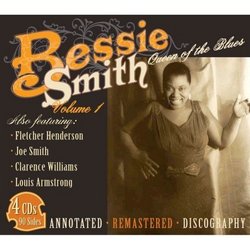Album DescriptionBessie Smith was not the first to record a blues - indeed her early career was not even as a blues singer - yet she stands astride the genre like a colossus. As well as her fame as an entertainer, she was a formidable human being. She simply refused to recognise opposition - incredibly, one night in 1927, she faced down the feared Ku Klux Klan. She was born poor in 1894, in Chattanooga, Tennessee. Both parents died while Bessie was still young and she was raised by her older sister, Viola. To augment Viola's meagre earnings as a laundress, Bessie and her older brother Clarence took to the streets as entertainers. In time, Bessie obtained regular work as a dancer and chorus girl. By 1921, when she was living in Philadelphia, Bessie was a star. She had several unsuccessful tests for recording companies. In February 1923, after she'd moved to New York, Columbia gave her a chance. Her first cuts, made on February 15th, are lost. However, the next day she recorded Gulf Coast Blues and Down Hearted Blues with piano backing by Clarence Williams, who had written the former.This combination was released as Bessie's first disc. It sold 750,000. All her skills are on display. Initially, Gulf Coast was the A-side, but it was the honesty and clarity of Down Hearted that people flocked to buy. Soon after her recording debut, Bessie and new husband, Jack Gee, discovered that she was signed not to Columbia, but to Clarence Williams, who was appropriating half Bessie's recording fee. The angry pair confronted Williams, who released Bessie from her contract. With Williams temporarily out of favour, a new piano accompanist was needed. Fletcher Henderson stepped in. He's featured on ten sides here and shows himself to be as self-effacing, if a little subtler, than Williams. By the end of June, with a decent supply of material in the can, Walker released Bessie for a Southern tour. Her hit record had preceded her and the shows were sell-outs. During this tour, Bessie also discovered the emerging power of radio. Most shows were then transmitted `live' so, while earning a fee for performing, she promoted her records. The final two cuts on CD:A feature Bessie duetting with fellow blues singer Clara Smith. Bessie generally kept other blueswomen at bay, but Clara was an exception. Her voice here is plaintive and flexible, but Bessie dominates. Having mainly confined her to piano accompaniment, Columbia now began adding extra instruments. The first two tracks on CD:B, have the singer in the company of a decent clarinettist and pianist. Presumably Fletcher Henderson was needed elsewhere because he was back the next day. From Bessie's January 1924 sides, Frosty Mornin' Blues is surely a gem - its more traditional blues instrumentation, with Harry Reser on guitar, draws a performance of feeling from Bessie - once she and Reser accommodate to to the slow rhythm. Reser returned to help Bessie deliver an ironic interpretation of Easy Come Easy Go Blues. After this session, it was back to live work in Nashville. She was popular with both white and black audiences in the south, although they were, of course, segregated. Other black performers seem to have modified their acts for whites, cleaning them up if necessary. Not Bessie. She was in the vanguard of a generation of black performers which wouldn't conform to the `yassuh' stereotype.


 Track Listings (23) - Disc #1
Track Listings (23) - Disc #1